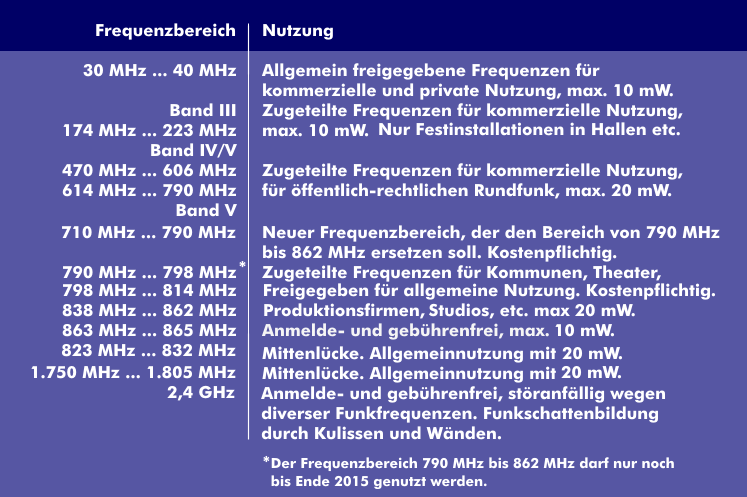radio microphone
Radio microphones are microphone systems that transmit their signals via radio, i.e., they operate wirelessly. The Regulatory Authority for Telecommunications and Posts(RegTP) has released several VHF and UHF frequencies for the use of radio microphones. In many cases, these are frequencies in the ISM bands. Depending on the frequency band, use is subject to registration, fees and licenses and is reserved for certain user groups or generally released.
A radio microphone is a microphone with a transmitter and receiver via which the microphone signals are transmitted from the transmitter to the receiver. The transmitter can be a pocket transmitter or integrated in handheld microphones. Pocket transmitters are mainly used with clip-on microphones such as lavalier microphones, headset microphones or headsets. The radio receiver is tuned to the transmitting frequency of the transmitters, it receives the radio frequencies, demodulates the modulated microphone signal and transmits the amplified speech signal by cable to the mixing console. To improve the transmission quality, the receiving equipment may be equipped with diversity and use multiple antennas.
Such a radio equipment can use different frequency ranges. Especially the UHF range from 790 MHz to 862 MHz is used by many manufacturers for radio microphones. This frequency range can continue to be used until the end of 2015, after which it can only be used with individual allocation for which a fee is charged. In 2011, the Federal Network Agency allocated two additional frequency ranges for general use: those between 823 MHz and 832 MHz and between 1,785 MHz and 1,800 MHz. These frequency ranges are referred to as center gaps because they are unused frequency ranges between the uplink and downlink of mobile communications systems.
Radio transmission and modulation
The radio transmission itself is in frequency modulation with a frequency deviation of 30 kHz or 40 kHz. The frequency deviation can be determined by the suppliers, but it is recommended to use transmitters with a higher frequency deviation for high-quality recordings. For some musical instruments, even a frequency deviation of 20 kHz may be sufficient. The number of radio channels can range from 4 to 48, depending on the wireless system. The transmitting power is subject to legal regulations. For example, a transmitting power of 10 mW is specified in the VHF range, and 20 mW in the UHF range.
The advantages of wireless microphone systems are the flexibility and mobility of the speaker and the quick installation of the microphone system without laying cables.


